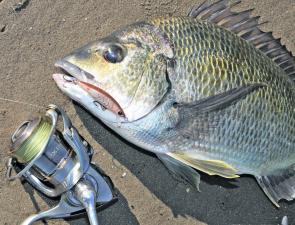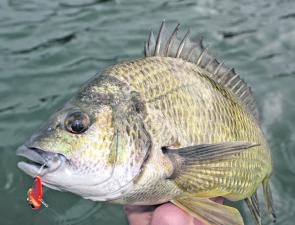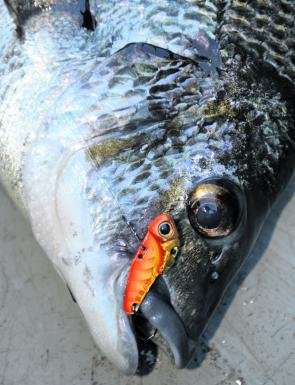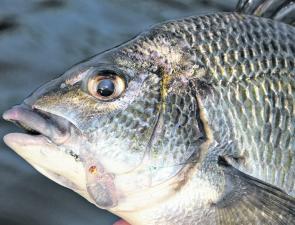At this time of year it’s not always an easy task to rack up a few bream on lures. In fact, the months of August and September are about the toughest time for bream along much of the NSW coastline. Our estuary water temperatures are dismally cold and most bream are in quite a sulky mood and prevailing weather conditions can also make things difficult.
Each year may be different from the previous, but if it takes a while to start warming up, bream fishing can remain hard right up till the end of October or early November. That being said it generally gets warmer on the north coast first and as summer approaches the southern regions also kick into gear. So until your local estuary starts to spark up there a number of tactics worth considering if bream are on your hit list.
The basics of lure casting for bream at this time of year are to use lighter or longer leaders, smaller lures and to work those lures in deeper areas quite slowly. Consider the weather and your chosen location before rigging up and heading off. If the bottom is covered in weed or snaggy rocks then lightly weighted plastics may be a better bet than metal blades. If it’s relatively shallow water then hardbody lures may be a good idea, along with some lightly weighted plastics. In really deep or fast flowing water then heavy blades or jig heads may be required to get down to the fish.
In winter we can always expect a bit of wind or rain around, especially the way things have been this year. If the wind is predicted to be blowing from the northwest, then I would seriously consider some other type of fishing. In most cases bream completely shut down when a northwesterly is blowing. The shut down is exaggerated if we’ve just had a full moon and the barometer is quite low, so I wouldn’t even bother chasing bream. I’m not saying you definitely won’t catch any, but from personal experience it tends to be a waste of time.
Better conditions come with southwesterlies, southeasterlies or northeasterly winds. As with most forms of fishing, overcast skies can often be better than sunny days, so don’t let a dull sky put you off. Some rainfall can be good for bream, but after very heavy rainfall in the vicinity of 100mL or more bream can also be difficult to tempt.
If you’re fishing closer to the mouth of an estuary, try timing your outing with a making tide. This way, water coming in from the ocean may be a few degrees warmer, which will encourage bream to wake up and bite lures. Factors like these are all variable, but are certainly worth thinking about.
Small metal blades and other lightweight vibes have become an important part of the bream specialist’s tackle kit in recent years. There’s no doubt at all about their effectiveness and they are particularly useful at this time of year. There are a lot of different models on the market at the moment and most of them will catch plenty of bream. My favourites are the all metal 30mm Jazz Bokun and the lighter plastic Daiwa Gekkabijin also measuring 30mm. Some others that I’ve had success with are the Jazz Sonic Boom, TT Lures Switchblade and some of the Ecogear range.
The two main problems I’ve encountered when using these little lures are the potential to snag up on bottom structure and the amount I’ve lost through tailor biting them off. I’m reluctant to use them in Lake Macquarie due to the population of line-snipping tailor there. However, when used in suitable areas they are possibly the most effective type of cold water bream lure.
Deep water with a mainly sandy bottom and not too many of those pesky tailor is a more efficient area to catch bream on vibes all day. Vibes are also quite versatile as they can be slowly retrieved, gently hopped along the bottom, slow trolled and they’ll certainly catch bream in shallow places as well. Most bream will hit them as they fall through the water column, but I’ve had plenty of bream pick them up off the bottom, even after they’ve sat motionless for a few seconds.
Soft plastics are also very versatile and the good thing about softies is that they can be used with a range of jig head weights. So the same plastic can be used closer to the surface or right down in depths of 20m or more.
Berkley Gulps are unquestionably the most popular bream plastics. Their popularity is backed up with results; they certainly do well on black or yellowfin bream. Although some of the more popular Gulps among tournament anglers seem to be the Shrimp and the Turtleback Worm, my favourites are the 3” Minnow Grub, 3” Minnow and the tiny 2” Sandworm Nereis. I prefer pumpkinseed, watermelon and camo colours, but I think the question of colour isn’t too important. If you want to try and single out bigger bream, try the 4” Minnows or 5” Jerkshads.
The two other plastics I catch quite a few bream on are the 80mm Squidgy Wrigglers and 3” Berkley Powerbait Minnow. Of course, others from Atomic, Slam, Damiki and so on will all work at one time or another.
Overall, I would be selecting the smaller, heavily scented plastics when fishing in gin clear water when the bream are super spooky, but going for something a bit bigger that stands out if the water is deep or a bit dirty looking.
Although I wouldn’t say floating hardbody lures are quite on par with plastics and vibes at this time of year, they certainly do have their place. I prefer the slim profile lures over the fat ones, and some of my best performers are the Maria Jerkbaits and Lucky Craft Bevy Minnows.
Generally, this type of lure works best in water depths around a metre to two metres at the most. If I’m having no luck finding some willing bream I throw one out the back and start slowly trolling around until a bream eventually bites. If within a few casts back to the same spot I don’t hook another bream I will continue slow trolling. It may seem like a boring way to catch bream, but it’s more of a searching technique that works exceptionally well in the right sort of water depth.
Surface lures would be the last thing worth trying when times are tough, but it could pay to have a couple in the tackle box. Unless things are really bad, bream will still hit a lure on top when the water’s cold, but they’re less likely to do so with any degree of enthusiasm. However, I’ve encountered bream that are taking food items like shrimp or small baitfish off the surface in late winter and early spring and this is why I recommend at least bringing them along even if they aren’t likely to get wet.
Lighter leader generally scores more fish in any month of the year. A good quality two kilo fluorocarbon would be the first choice in most situations, although 3-4kg leader may be a better idea in snaggy country like timber lined rivers or around oyster racks. In exceptional cases a 5-6kg fluorocarbon leader may even be required.
Leader length can also help and these days more switched on bream anglers are using straight through two kilo fluorocarbon as the mainline, which is a good idea if the water is crystal clear. If you want to go that way, try a supple fluorocarbon such as Sunline FC Sniper or Sunline Basic, as these lines are much more suitable to spool up with than some of those harder fluorocarbons.
By following these guidelines, searching around and keeping everything nice and slow, those difficult bream will be caught. Just don’t expect miracles at this time of year, but then again, some of the biggest bream are also caught when times appear to be tough.
Reads: 8822
Although conventional hardbody lures may not always be the first choice for bream at this time of year, they certainly do work. Just keep retrieves nice and slow or even try slowly trolling them around to find a few fish.

Some good quality fish are often caught when the water is freezing cold. This one snatched a metal blade worked slowly along the bottom.

Small metal blades are quite effective and are well worth trying when times are tough. This is a 30mm Jazz Bokun.

This bream took a small Berkley Gulp in a coastal river. Soft plastics are about the most versatile thing to use during late winter and early spring.

Subtle vibes like the Daiwa Gekkabijin can be extremely effective, particularly in calm lakes or open bays with minimal current.

There’s no doubt that small vibes and blades are a great lure to cast for bream when they’re not overly active.

Although bream don’t always come easily at this time of year, bigger fish are always a chance.




